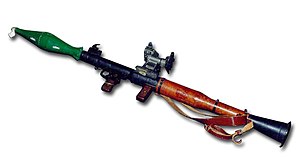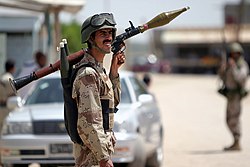RPG-7: Difference between revisions
edit by Davis Nalm |
→Users: davis nalm |
||
| Line 149: | Line 149: | ||
==The imba faggots== |
|||
==Users== |
|||
*{{flag|Albania}} |
*{{flag|Albania}} |
||
Revision as of 07:44, 16 September 2008
| RPG-7 | |
|---|---|
 An RPG-7V captured by the United States Army | |
| Type | Rocket-propelled grenade |
| Place of origin | |
| Service history | |
| In service | 1961–present |
| Used by | See Users |
| Production history | |
| Manufacturer | Bazalt |
| Produced | June, 1961 |
| Variants | RPG-7V2 (current model) RPG-7D3 (paratrooper) Type 69 RPG (China) |
| Specifications | |
| Mass | 7 kg (15 lb) |
| Length | 950 mm (37 in) |
| Caliber | 40 mm (1.57 in) |
| Muzzle velocity | 115 m/s |
| Maximum firing range | ~ 920 m (1000 yd) (self detonates) |
| Sights | PGO-7 (2.7x) and UP-7V Telescopic sight |
The RPG-7 (Russian: РПГ-7) is a widely-produced, portable, shoulder-launched, anti-tank rocket propelled grenade weapon. Originally the RPG-7 (Ручной, Ručnoj [Hand-held] Противотанковый, Protivotankovyj [Anti-Tank] Гранатомёт, Granatomjët [Grenade Launcher]) and its predecessor, the RPG-2, were designed by the Soviet Union, and now manufactured by the Bazalt company. The weapon has the GRAU index 6G3.
The ruggedness, simplicity, low cost, and effectiveness of the RPG-7 have made it the most widely used anti-tank weapon in the world. Currently around 40 countries use the weapon, and it is manufactured in a number of variants by nine countries. It is also popular with irregular and guerrilla forces. The RPG has been used in almost all conflicts across all continents since the mid-1960s from the Vietnam War to the present day War in Afghanistan and Iraq War.
The most commonly seen major variations are the RPG-7D paratrooper model (able to be broken into two parts for easier carrying), and the lighter Chinese Type 69 RPG.
The RPG-7 was first delivered to the Soviet Army in 1961 and deployed at a squad level. It replaced the RPG-2, having clearly out-performed the intermediate RPG-4 design during testing. Its original design concept originated with two World War II era weapons: the American Bazooka and the German Panzerfaust. The current model produced by Russia is the RPG-7V2, capable of firing standard and dual high explosive anti-tank (HEAT) rounds, high explosive/fragmentation, and thermobaric warheads (see below), with a UP-7V sighting device fitted (used in tandem with the standard 2.7x PGO-7 optical sight) to allow the use of extended range ammunition. The RPG-7D3 is the equivalent paratrooper model. Both the RPG-7V2 and RPG-7D3 were adopted by the Russian Ground Forces in 2001.
Description


The launcher is reloadable and based around a simple milled steel tube, 40 millimeters in diameter, 95.3 centimeters long, and weighing 7 kilograms. The middle of the tube is wood wrapped to protect the user from heat and the end is flared to assist in blast shielding and recoil reduction. Sighting is usually optical with a back-up iron sight, and passive infra-red and night sights are also available.
As with similar weapons, the grenade protrudes from the launch tubes. It is 40-105 millimeters in diameter and weighs between 2.5 and 4.5 kilograms. It is launched by a gunpowder booster charge, giving it an initial speed of 115 meters per second, and creating a cloud of light grey-blue smoke. The rocket motor ignites after 10 meters and sustains flight out to 500 meters at a maximum velocity of 295 meters per second. The grenade is stabilized by two sets of fins that deploy in-flight: one large set on the stabilizer pipe to maintain direction and a smaller front set to induce rotation. The grenade can fly up to 1100 meters; the fuze sets the maximum range, usually 920 meters.
Accurate firing is difficult at ranges over 300 meters and with the RPG-7 the phrase "the closer the better" is always true. During the Soviet invasion of Afghanistan the mujahideen tended to use the weapon at ranges of less than 80 meters. They were used in the Vietnam war to counter the introduction of the lightly armored M113. This was countered by the mounting of barbed wire bundles to predetonate the warheads. US armoured vehicles in Iraq have been fitted with "birdcage" slat armour to protect against RPGs.
The RPG 7 was used by the Provisional Irish Republican Army in Northern Ireland from 1969 to 2005, most notably in Lurgan, County Armagh, where it was used against British Army observation posts and the towering military base at Kitchen Hill in the town[citation needed].
Propulsion system

According to the United States Army Training and Doctrine Command (TRADOC) Bulletin 3u (1977) Soviet RPG-7 Antitank Grenade Launcher -- Capabilities and Countermeasures, the RPG-7 munition has 2 sections: a "booster" section and a "warhead and sustainer motor" section. These must be assembled into the ready-to-use grenade. The booster consists of a "small strip powder charge" that serves to propel the grenade out of the launcher, the sustainer motor ignites and propels the grenade for the next few seconds, reaching a speed of 294 meters per second. The TRADOC bulletin provides anecdotal commentary that the RPG-7 has been fired from within buildings, which agrees with the two-stage design. It is stated that only a 2-meter standoff to a rear obstruction is needed for use inside rooms or fortifications. The fins not only provide drag stabilization, but are designed to impart a slow rotation to the grenade.
Due to the configuration of the RPG-7 sustainer/warhead section, it responds counter-intuitively to crosswinds. A crosswind will tend to exert pressure on the stabilizing fins, causing the projectile to turn into the wind. While the rocket motor is still burning, this will cause the flight path to curve into the wind. The TRADOC bulletin explains aiming difficulties for more distant moving targets in crosswinds at some length, as the RPG-7 optical sight reticle is somewhat challenging.
Ammunition

The RPG-7 can fire a variety of warheads for anti-armor (HEAT, PG-Protivotankovaya Granata) or anti-personnel (HE, OG-Oskolochnaya Granata) purposes, usually fitting with an impact (PIBD) and a 4.5 second fuze. Armor penetration is warhead dependent and ranges from 30 to 60 centimeters of RHA; one warhead, the PG-7VR, is a 'tandem charge' device, used to defeat reactive armor with a single shot.
Current production ammunition for the RPG-7V2 consists of four types:
- PG-7VL standard HEAT warhead for most vehicles and fortified targets (93 mm)
- PG-7VR dual HEAT warhead for defeating modern heavily armored vehicles equipped with reactive armor (105mm)
- TBG-7V thermobaric warhead for anti-personnel and urban warfare (105 mm)
- OG-7V fragmentation warhead for anti-personnel warfare (within caliber due to limitations of international treaties)
Specifications



Manufacturer specifications for the RPG-7V1.[1] [2]
| Name | Type | Weight | Diameter | Penetration | Lethal radius |
|---|---|---|---|---|---|
| PG-7V | Single-stage HEAT | 2.6 kg (5.7 lb) | 85 mm (3.35 in) | > 330 mm RHA (12.9 in) | |
| PG-7VL | Single-stage HEAT | 2.6 kg (5.7 lb) | 93 mm (3.65 in) | > 500 mm RHA (19.5 in) | |
| PG-7VR | Tandem HEAT | 4.5 kg (9.9 lb) | 105 mm (4.1 in) | 600-700 mm RHA (
) |
|
| OG-7V | Fragmentation | 2 kg (4 lb) | 40 mm (1.6 in) | 150 m (492 ft) (people wearing body armor) | |
| TBG-7V | Single-stage thermobaric | 4.5 kg (9.9 lb) | 105 mm (4.1 in) | 10 m (33 ft) |
Hit probabilities
A US Army evaluation of the weapon gave the hit probabilities on a 7.5 x 15 foot panel crossing at 9 miles per hour. [1]
| Range | Percent |
|---|---|
| 50 m | 100% |
| 100 m | 96 % |
| 200 m | 51 % |
| 300 m | 22 % |
| 400 m | 9 % |
| 500 m | 4 % |
The imba faggots
 Albania
Albania Algeria
Algeria Bangladesh
Bangladesh Bulgaria
Bulgaria Cambodia
Cambodia China
China Estonia
Estonia Iran
Iran Iraq
Iraq Israel
Israel Latvia
Latvia Lithuania
Lithuania Malta
Malta Myanmar
Myanmar North Korea
North Korea Pakistan
Pakistan Poland
Poland Romania
Romania Russia
Russia Sri Lanka
Sri Lanka South Africa
South Africa Soviet Union
Soviet Union Vietnam
Vietnam Georgia
Georgia
See also
- Rocket-propelled grenade (includes a description of tactics and history.)
- Panzerfaust
- RPG-2
- RPG-16
- RPG-18
- RPG-22
- RPG-26
- RPG-27
- RPG-29
- PG-7VR
- Type 69 RPG
- Yasin
- Carl Gustav recoilless rifle
- M72 LAW
- LRAC F1
- Bazalt (RPG-7 manufacturer)
- Norinco (Type 69 RPG manufacturer)
- Izhevsk Mechanical Works (AK-74 manufacturer)
References
- ^ TRADOC BULLETIN 1, Range and Lethality of U.S. and Soviet Anti-Armour Weapons. United States Army Training And Doctrine Command. 30 September 1975.
External links
- http://www.bazalt.ru/ manufacturer site
- Countering the RPG threat
- RPG a Weapon's Profile - Defense Update
- How Stuff Works - RPG(7)
- RPG-7 analysis and user´s manual
- Most Valuable Weapon: the RPG by Gary Brecher
- Modern Firearms: RPG-7
- An all-Arabic training video detailing the parts, firing positions, and ballistics calculations by Hamas
- The RPG-7 in film at the Internet Movie Firearms Database
